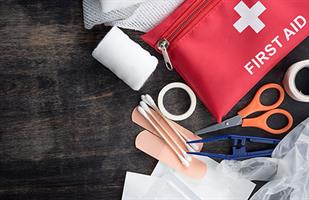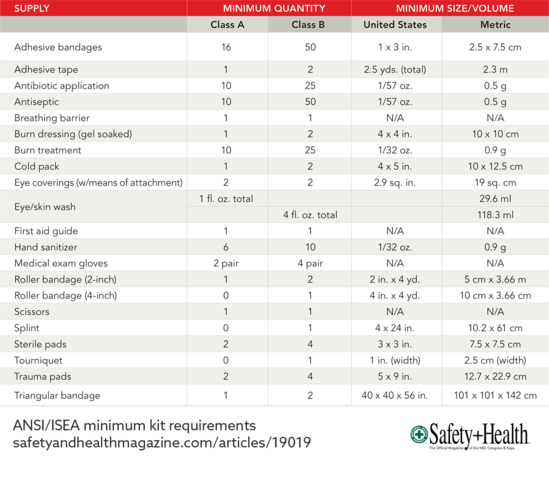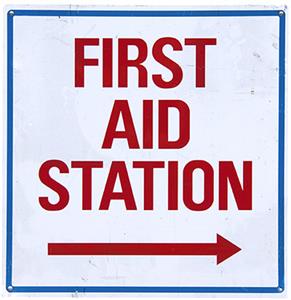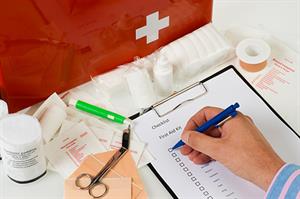First Aid

All employers must have a plan for First Aid Response to be prepared for potential dangers in the workplace. Each workplace, even each printing facility, is unique and holds different safety risks. Therefore, all the elements of a first aid response plan—such as a First Aid Policy, company-specific contents of the first aid kit, First Aid Inspection Checklist, Incident Reporting Form, and employee training—should uniquely fit your facility's needs.
First Aid Policy
A First Aid Policy sets out the measures the company will take to ensure that workers who suffer injuries or illnesses have the necessary first aid treatment available. Below is a list of the minimum criteria of a robust First Aid Policy. PRINTING United Alliance has a customizable First Aid Policy template that you can add your company’s specifics to.
- A first-aid needs-assessment based on:
- The degree of hazard associated with on-site work
- Amount of people working on-site
- Estimated response time of from the nearest medical professionals
- If outside medical help is unable to respond within the 3-4 minutes, an internal Response Plan is required.
- Based on needs-assessment, a list of specific contents each first aid kit in the workplace must contain.
- First Aid Incident Report Procedure
- Including a Bloodborne Pathogens Exposure Control Plan. Use PRINTING United Alliance's template.
- Training Procedures for employees
First Aid Kit Content Requirements
ANSI/ISEA (American National Standards Institute/ International Safety Equipment Association) Standard Z308.1-2015 is the standard that OSHA enforces for the minimal contents of first aid kits, however, it is up to the employer to both identify and include all other necessary items.
Under this standard, you are not allowed to assemble your own compliant first aid kit. You can obtain a compliant kit from an industrial distribution of personal protective equipment, or PPE. Neither you nor your employees may remove any of the kit requirements, but you are allowed to add items based on your work environment. There are two types of compliant first aid kits:
- Class A First Aid Kits generally are suitable for all wounds, minor burns and eye injuries.
- Class B First Aid Kits are designed to treat injuries more often found in densely populated workplaces with complex and/or high-risk environments, such as warehouses, factories and outdoor areas.
General industry workplaces must have the items for bleeding control listed for Class A kits. If the workplace has a high risk of serious injuries, the items listed for Class B kits, including tourniquets, are required. Thus, OSHA strongly recommends that industries where amputations are likely, such as the printing industry and other industries in OSHA’s National Emphasis Program, use Class B kits.

Kits in compliance with Z308.1-2015 feature supplies arranged in uniform, color-coded boxes to ease organization:
- Blue for antiseptics
- Yellow for bandages
- Red for burn treatment
- Orange for personal protective equipment
- Green for miscellaneous items
In addition, kits are organized into one of four types based on work environment:
- Type I Containers are mountable and intended for stationary, indoor settings
- Type II Portable and intended for indoor use
- Type III Must be portable, mountable and have a water-resistant seal
- Type IV Must be portable, mountable and waterproof
Common Additional Items
As mentioned above, first aid kits must include supplies specific to the risks within each workplace. For example, stretchers and emergency blankets to help prevent shock can be added to basic first aid kits. An AED is also a common addition as sudden cardiac arrest can be a hazard among workers across all industries. If an AED is provided, employees that will be using the device need training on its function and use.
Eyewash and Safety Showers
OSHA requires facilities where employees handle substances that could injure their eyes or get onto their bodies to provide eyewash stations or showers (or both), based on the hazard. Several key elements include:
- An unobstructed path; eyewash or shower accessible within 10 seconds
- Installation meets manufacturer’s requirements including criteria for water pressure, flow rate, and system testing
- Water must flow for at least 15 minutes. Valves must remain open without the use of hands
- Eyewash or shower stations must be clean, sanitary, and operating correctly; expired solutions must not be used in self-contained systems
OSHA defers to the American National Standards Institute (ANSI) and their consensus standard Z358.1 regarding the specifics for eyewash stations and safety showers. Additional information can be found at Oregon OSHA’s Eyewash and Safety Showers Factsheet, the ANSI Standard for Emergency Eyewash and Shower Equipment, and MNOSHA’s Emergency Eyewash and Showers Overview.
Posted First Aid Notices for Workers
 Notices should be posted around the
workplace to inform workers of how and where to obtain first aid. This information must be easily accessible and visible to all building occupants and should include:
Notices should be posted around the
workplace to inform workers of how and where to obtain first aid. This information must be easily accessible and visible to all building occupants and should include:
- The location of first aid kits and first aid stations (including eyewash stations)
- Procedures to summon emergency medical treatment
- Contact information for nearest police, fire station, EMT or ambulance, medical facility, and other emergency contacts
- Names and work locations of trained first aid personnel in the workplace
First Aid Inspection Checklist
The items listed in the above sections should be maintained and regularly updated to ensure all employees have accurate response information and that the workplace is always equipped with necessary response materials. A First Aid Inspection Checklist will hold you accountable for completing regular inspections and ensure your workplace is prepared to administer first aid. An inspection checklist should verify:
- First-aid needs assessment is accurate based on potential dangers of the workplace
- First aid kits are in easily accessible locations, stocked with necessary items, and inventory is accurate
- First aid notices are posted in visible sites and have accurate information
- Eyewash and shower units are in compliance with ANSI Z358.1-2014
- When required, employees have been adequately trained and attend regular refresher courses
Injury and Illness Reporting and Recording
 Employees need to be instructed
as to when and how to report an injury, even ones that are considered minor. OSHA has focused on ensuring that employers have a clear and understandable reporting procedure and PRINTING United Alliance has developed a Sample Injury and Illness Reporting Policy that can be modified for your workplace.
Employees need to be instructed
as to when and how to report an injury, even ones that are considered minor. OSHA has focused on ensuring that employers have a clear and understandable reporting procedure and PRINTING United Alliance has developed a Sample Injury and Illness Reporting Policy that can be modified for your workplace.
Under OSHA’s injury and illness recordkeeping requirements, any injury that requires treatment beyond first aid must be recorded within 7 days in OSHA’s Form 300. A list of first-aid considerations can be on OSHAs First Aid List.
If an injury only requires first aid, regardless of who administers it, a best practice would be to keep an internal record of all injuries and illnesses that occur that required only first aid measures. Keeping a First Aid Incident Reporting Form, (which we have included in our First Aid Policy template) in a safe location will allow for accurate and timely reporting of injuries and illnesses. These log forms should include the following information:
- Time, date, location and a brief description of the injury
- How it occurred
- The name and position of the injured worker
- Names and contact information of witnesses
- The treating provider(s)
- The treatment provided
- Whether the worker was transported to a medical facility
- Acknowledgement that the worker was advised to seek medical treatment if the condition worsened
A First Aid Refusal Form is also another suggestion to have in case an employee refuses first aid treatment. Workers are not required to accept first aid treatment or emergency transport. However, they can be required to sign a refusal form if such treatment was offered and turned down.
For more information on what injuries and illnesses must be reported to OSHA, see our OSHA Recordkeeping Rule page.
Formal First Aid Training Program
Since printing operations are classified as manufacturing, the need to have a formal First Aid Program with trained employees is based on emergency medical service response time. In a printing facility, where serious accidents such as those involving falls, suffocation, electrocution, or amputation are possible, emergency medical services must be available within 3-4 minutes. If outside medical services are not reasonably able to arrive on-site within this time, there must be an on-site employee that is trained to render first aid present at all times.
OSHA does not certify first aid training programs, instructors, or trainees. However, they recognize any nationally accepted and medically sound first aid program that covers the fundamentals of first aid as meeting the requirements stated in 29 CFR 1910.151. The specific content of first aid programs must be consistent with the work environment in question, and with the type of work being done.
Employers in general industry providing first aid training must ensure it adequately covers the types of injuries/illnesses likely to be encountered in their workplaces and is kept up to date with current first aid techniques and knowledge.
PRINTING United Alliance’s OSHA Compliance Resource Center provides technical assistance and services designed to allow printing operations to manage compliance and stay informed. For more information on First Aid Requirements or PRINTING United Alliance’s EHS services, email govtaffairs@sgia.org or call 888-385-3588.